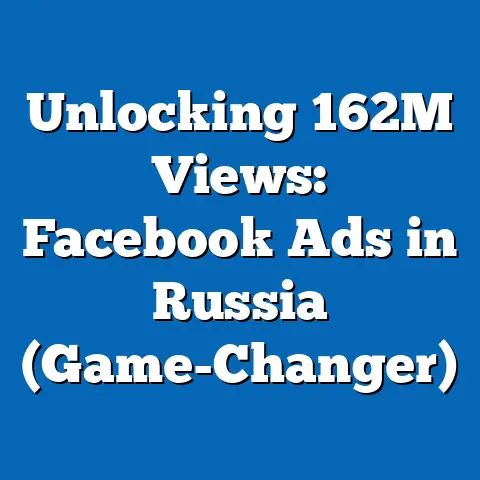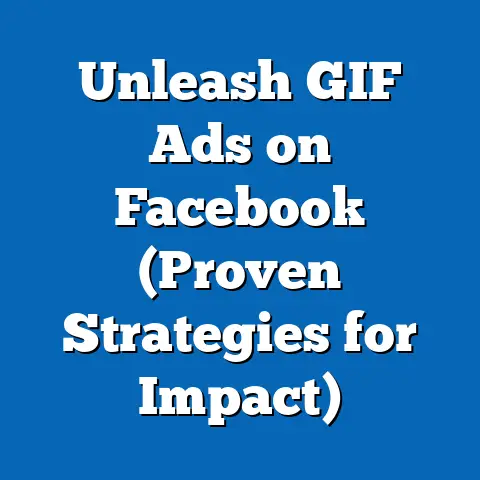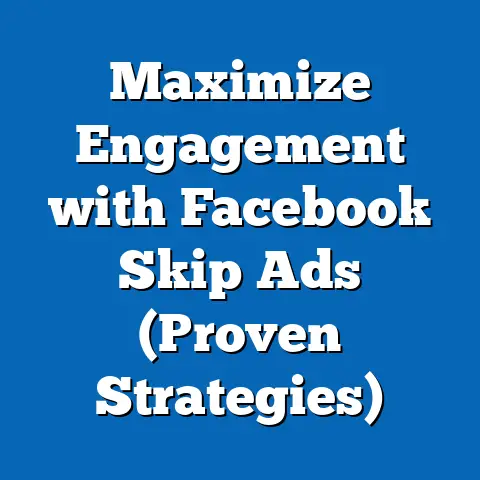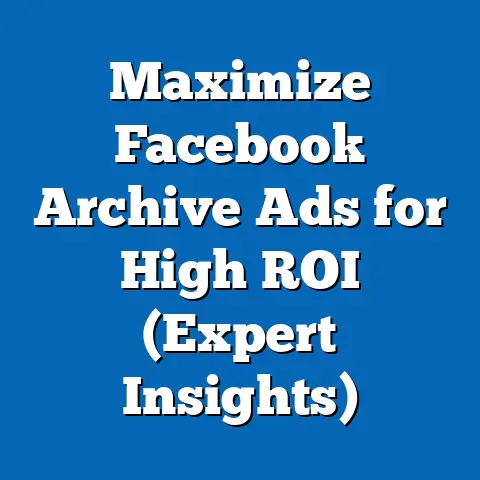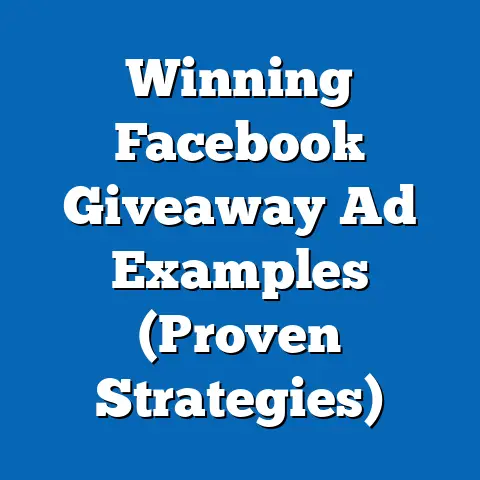Top Facebook Ads Examples That Drive Conversions (Pro Insights)
Facebook advertising has become a cornerstone of modern digital marketing. With billions of active users, the platform offers unparalleled opportunities for businesses to reach their target audiences and drive conversions. But let’s face it, not all Facebook ads are created equal. Some soar, captivating users and turning them into loyal customers, while others fall flat, lost in the endless scroll. The key to success lies in understanding what makes an ad truly effective and how to apply those principles to your own campaigns.
In this article, I’ll be diving deep into some of the top Facebook ad examples that have demonstrably driven conversions. I’ll break down each ad, analyzing the creative elements, targeting strategies, and calls-to-action that contributed to their success. But before we jump into the examples, it’s crucial to understand the foundation upon which all successful Facebook ad campaigns are built: a well-defined budget. We’ll explore the different types of budgets available and how to strategically allocate your funds to maximize your ROI.
Understanding Facebook Ad Budgets
Before even thinking about creative or targeting, understanding and setting your Facebook ad budget is the first crucial step. It’s not just about throwing money at the platform; it’s about strategically investing in your campaigns to achieve the best possible results. Facebook offers two primary budget options: daily budgets and lifetime budgets. Each has its own advantages and disadvantages, and the right choice depends on your specific campaign goals and advertising strategy.
Types of Budgets
-
Daily Budgets: A daily budget allows you to set a specific amount that Facebook can spend on your ads each day. Think of it as your daily allowance for advertising. The platform will then try to spend close to that amount each day, although it can fluctuate slightly. For example, if you set a daily budget of $20, Facebook might spend anywhere from $18 to $22 on a given day.
- Why it’s important: Daily budgets are ideal for campaigns that run continuously or for those where you want to maintain a consistent level of ad delivery. They provide flexibility and control, allowing you to easily adjust your spending as needed. I often recommend daily budgets for ongoing brand awareness campaigns or for businesses that want to maintain a steady stream of leads.
-
Lifetime Budgets: A lifetime budget allows you to set a total amount you’re willing to spend over the entire duration of your campaign. Facebook will then optimize your ad delivery to spend that amount evenly (or unevenly, depending on your optimization goals) over the specified period.
-
Why it’s important: Lifetime budgets are great for campaigns with a specific end date, such as a limited-time promotion or a seasonal campaign. They provide predictability and ensure that you don’t exceed your overall budget. I’ve personally used lifetime budgets extensively for holiday campaigns, ensuring that I stay within my allocated spending for the entire promotional period.
Daily Budgets: A daily budget allows you to set a specific amount that Facebook can spend on your ads each day. Think of it as your daily allowance for advertising. The platform will then try to spend close to that amount each day, although it can fluctuate slightly. For example, if you set a daily budget of $20, Facebook might spend anywhere from $18 to $22 on a given day.
- Why it’s important: Daily budgets are ideal for campaigns that run continuously or for those where you want to maintain a consistent level of ad delivery. They provide flexibility and control, allowing you to easily adjust your spending as needed. I often recommend daily budgets for ongoing brand awareness campaigns or for businesses that want to maintain a steady stream of leads.
-
Lifetime Budgets: A lifetime budget allows you to set a total amount you’re willing to spend over the entire duration of your campaign. Facebook will then optimize your ad delivery to spend that amount evenly (or unevenly, depending on your optimization goals) over the specified period.
-
Why it’s important: Lifetime budgets are great for campaigns with a specific end date, such as a limited-time promotion or a seasonal campaign. They provide predictability and ensure that you don’t exceed your overall budget. I’ve personally used lifetime budgets extensively for holiday campaigns, ensuring that I stay within my allocated spending for the entire promotional period.
Lifetime Budgets: A lifetime budget allows you to set a total amount you’re willing to spend over the entire duration of your campaign. Facebook will then optimize your ad delivery to spend that amount evenly (or unevenly, depending on your optimization goals) over the specified period.
Why it’s important: Lifetime budgets are great for campaigns with a specific end date, such as a limited-time promotion or a seasonal campaign. They provide predictability and ensure that you don’t exceed your overall budget. I’ve personally used lifetime budgets extensively for holiday campaigns, ensuring that I stay within my allocated spending for the entire promotional period.
Choosing the right budget type is critical because it directly impacts how your ads are delivered and how visible they are to your target audience. A daily budget provides consistent exposure, while a lifetime budget allows you to control your total spending over a defined period.
Takeaway: Carefully consider your campaign goals and timeline when choosing between daily and lifetime budgets.
Setting Your Budget
Setting your Facebook ad budget isn’t just about picking a random number. It’s a strategic process that involves careful consideration of your business goals, target audience, and marketing objectives. Here’s a step-by-step approach I often use with my clients:
- Define Your Business Goals: What do you want to achieve with your Facebook ads? Are you looking to increase brand awareness, generate leads, drive sales, or something else? Clearly defining your goals will help you determine how much you’re willing to spend to achieve them.
- Identify Your Target Audience: How large is your target audience on Facebook? The larger your audience, the more you’ll likely need to spend to reach them effectively. Use Facebook’s Audience Insights tool to estimate the size of your potential audience.
- Analyze Your Marketing Objectives: How aggressive do you want to be with your advertising? Are you looking to dominate your niche, or are you content with a more modest approach? Your marketing objectives will influence the intensity of your ad campaigns and, consequently, your budget.
-
Review Past Ad Performance Data: If you’ve run Facebook ads in the past, analyze your performance data to see what worked and what didn’t. Which campaigns generated the best ROI? Which targeting options were most effective? Use this data to inform your budget decisions for future campaigns.
- I remember one client who was hesitant to increase their ad budget, even though their previous campaigns had generated a significant return on investment. After showing them the data and demonstrating the potential for even greater returns with a larger budget, they agreed to increase their spending, and we saw a substantial increase in sales.
Review Past Ad Performance Data: If you’ve run Facebook ads in the past, analyze your performance data to see what worked and what didn’t. Which campaigns generated the best ROI? Which targeting options were most effective? Use this data to inform your budget decisions for future campaigns.
- I remember one client who was hesitant to increase their ad budget, even though their previous campaigns had generated a significant return on investment. After showing them the data and demonstrating the potential for even greater returns with a larger budget, they agreed to increase their spending, and we saw a substantial increase in sales.
Takeaway: Setting a practical ad budget requires a thorough understanding of your business goals, target audience, and past performance data.
Budget Allocation Strategies
Once you’ve determined your overall Facebook ad budget, the next step is to allocate it strategically across your various campaign objectives. It’s not enough to simply divide your budget evenly; you need to prioritize the objectives that are most important to your business.
- Prioritize Your Objectives: Which objectives are most critical to your business success? Are you more focused on brand awareness or lead generation? Allocate a larger portion of your budget to the objectives that will have the biggest impact on your bottom line.
- Consider Your Sales Funnel: Think about your sales funnel and how Facebook ads can contribute to each stage. Allocate budget to both top-of-funnel (awareness) and bottom-of-funnel (conversion) campaigns.
-
A/B Testing with Budget Allocation: Experiment with different budget allocations to see what works best. Try allocating more budget to certain campaigns or ad sets and track the results. A/B testing with budget allocation can help you identify the most efficient ways to spend your advertising dollars.
- I’ve found that A/B testing with budget allocation can be incredibly effective in optimizing campaign performance. For example, I once ran a campaign where I allocated 70% of the budget to a conversion-focused ad set and 30% to a brand awareness ad set. After a week, I analyzed the results and discovered that the brand awareness ad set was actually generating more leads at a lower cost. I then reallocated the budget to give the brand awareness ad set a larger share, which resulted in a significant increase in overall campaign performance.
A/B Testing with Budget Allocation: Experiment with different budget allocations to see what works best. Try allocating more budget to certain campaigns or ad sets and track the results. A/B testing with budget allocation can help you identify the most efficient ways to spend your advertising dollars.
- I’ve found that A/B testing with budget allocation can be incredibly effective in optimizing campaign performance. For example, I once ran a campaign where I allocated 70% of the budget to a conversion-focused ad set and 30% to a brand awareness ad set. After a week, I analyzed the results and discovered that the brand awareness ad set was actually generating more leads at a lower cost. I then reallocated the budget to give the brand awareness ad set a larger share, which resulted in a significant increase in overall campaign performance.
Takeaway: Strategic budget allocation is essential for maximizing the impact of your Facebook ad campaigns.
Now that we’ve covered the fundamentals of Facebook ad budgeting, let’s move on to the exciting part: analyzing some of the top Facebook ad examples that have successfully driven conversions.
Top Facebook Ad Examples Driving Conversions
Successful Facebook ads are more than just pretty pictures and catchy slogans. They’re a carefully crafted combination of creativity, strategic targeting, and compelling calls-to-action. They resonate with the target audience, address their needs and desires, and ultimately persuade them to take action.
Let’s dive into some specific examples and dissect what makes them so effective.
Example 1: [Warby Parker] – The Power of Visual Storytelling
Warby Parker, the eyewear company, consistently nails their Facebook ads. One particular ad that stands out features a visually appealing image of someone wearing their glasses in a natural, everyday setting. The image is clean, well-lit, and instantly grabs your attention.
- Why it works: The ad’s success lies in its ability to tell a story without words. The image evokes a sense of style, sophistication, and everyday practicality. The copy is concise and focuses on the benefits of Warby Parker’s glasses, such as their affordable prices and convenient home try-on program.
- Emotional Appeal: The ad taps into the desire to look good and feel confident. The image suggests that wearing Warby Parker glasses can enhance your personal style and make you feel more attractive.
- Clear Messaging: The ad clearly communicates the key benefits of Warby Parker’s glasses, such as their affordability and convenience.
- Effective Targeting: Warby Parker likely targeted this ad to individuals interested in fashion, eyewear, and online shopping.
- Data & Metrics: Warby Parker’s Facebook ads consistently generate high engagement rates, with users liking, commenting, and sharing the ads. They also report strong conversion rates, with a significant percentage of ad viewers ultimately purchasing glasses.
Takeaway: Use high-quality visuals to tell a story and evoke emotions. Keep your messaging concise and focus on the benefits of your product or service.
Example 2: [GoPro] – Leveraging User-Generated Content
GoPro is a master of user-generated content (UGC). Their Facebook ads often feature videos and photos taken by their customers, showcasing the incredible adventures and experiences that are possible with a GoPro camera.
- Why it works: UGC is incredibly powerful because it’s authentic and relatable. People trust the opinions of other customers more than they trust traditional advertising. By featuring UGC in their ads, GoPro leverages the power of social proof to drive conversions.
- Social Proof: Seeing other people using and enjoying GoPro cameras makes potential customers more likely to believe in the product’s value and quality.
- Authenticity: UGC feels more genuine and less staged than traditional advertising, which can build trust and credibility.
- Conversion Metrics: GoPro’s UGC-driven ads consistently generate high click-through rates and conversion rates. They also report a significant increase in brand awareness and social media engagement.
- Customer Feedback: Customers rave about GoPro’s UGC ads, praising their authenticity and inspiring content.
Takeaway: Incorporate user-generated content into your Facebook ads to leverage the power of social proof and build trust with potential customers.
Example 3: [Amazon] – Dynamic Product Ads
Amazon excels at using dynamic product ads to retarget visitors who have shown interest in specific products on their website. If you’ve ever browsed a product on Amazon and then seen an ad for that same product on Facebook, you’ve experienced the power of dynamic product ads.
- Why it works: Dynamic product ads are highly personalized and relevant, which makes them incredibly effective. By showing people ads for products they’ve already expressed interest in, Amazon significantly increases the likelihood of a conversion.
- Personalization: Dynamic product ads are tailored to each individual user’s browsing history and product preferences.
- Relevance: The ads show products that the user has already expressed interest in, making them highly relevant and likely to capture their attention.
- Conversion Rates: Amazon’s dynamic product ads are known for their high conversion rates. They report a significant increase in sales and revenue as a result of using this ad format.
Takeaway: Use dynamic product ads to retarget website visitors and show them ads for products they’ve already expressed interest in.
Example 4: [Starbucks] – Seasonal Promotions and Urgency
Starbucks is a master of seasonal promotions and creating a sense of urgency in their Facebook ads. During the holidays, they often run ads featuring their festive drinks and limited-time offers.
- Why it works: The combination of seasonal relevance and urgency creates a powerful incentive for people to take action. The limited-time nature of the promotion encourages people to visit Starbucks sooner rather than later, driving sales and foot traffic.
- Scarcity: The limited-time offer creates a sense of scarcity, making people feel like they need to act quickly to avoid missing out.
- Urgency: The promotion encourages people to visit Starbucks sooner rather than later, driving immediate sales.
- Sales & Customer Acquisition: Starbucks reports a significant increase in sales and customer acquisition during their seasonal promotions.
Takeaway: Use seasonal promotions and limited-time offers to create a sense of urgency and drive immediate sales.
Example 5: [BuzzFeed] – Interactive Ad Formats
BuzzFeed is known for its engaging and interactive content, and they’ve successfully translated that approach to their Facebook ads. They often use interactive ad formats, such as polls and quizzes, to capture users’ attention and drive engagement.
- Why it works: Interactive ads are more engaging than static ads because they require users to actively participate. This increased engagement can lead to higher brand recall and conversion rates.
- Engagement: Interactive ads capture users’ attention and encourage them to participate, leading to higher engagement rates.
- Brand Recall: Engaging with an interactive ad can help users remember the brand and its message more effectively.
- Engagement Rates: BuzzFeed’s interactive ads consistently generate high engagement rates, with users actively participating in polls and quizzes.
Takeaway: Experiment with interactive ad formats, such as polls and quizzes, to capture users’ attention and drive engagement.
Example 6: [Dollar Shave Club] – Targeting Niche Audiences
Dollar Shave Club built its brand by effectively targeting a specific niche audience: men who are tired of overpaying for razors. Their Facebook ads often feature humorous and relatable content that resonates with their target audience.
- Why it works: By focusing on a specific niche audience, Dollar Shave Club can create ads that are highly relevant and engaging. Their ads address the pain points of their target audience and offer a compelling solution at an affordable price.
- Relevance: The ads are tailored to the specific needs and interests of the target audience.
- Engagement: The humorous and relatable content resonates with the target audience, leading to higher engagement rates.
- Case Study Results: Dollar Shave Club’s targeted Facebook ads have been instrumental in their rapid growth and success.
Takeaway: Identify your niche audience and create ads that are highly relevant and engaging to their specific needs and interests.
Key Takeaways from These Examples
Analyzing these successful Facebook ad examples reveals several common themes and strategies:
- Creativity: The most effective ads are visually appealing, engaging, and tell a compelling story.
- Audience Targeting: Understanding your target audience and tailoring your ads to their specific needs and interests is crucial.
- Clear Calls-to-Action: Make it easy for people to take action by including clear and concise calls-to-action in your ads.
- Budget Awareness: How each ad is budgeted for can greatly impact the success of the campaign.
Conclusion
Facebook ads are a powerful tool for driving conversions and achieving your business goals. By understanding the principles of effective advertising and drawing inspiration from successful examples, you can create campaigns that resonate with your target audience and generate a significant return on investment. Remember to be creative, strategic, and always test and optimize your ads to achieve the best possible results. So, take these examples, learn from them, and start crafting your own Facebook ads that drive conversions and help your business thrive!

